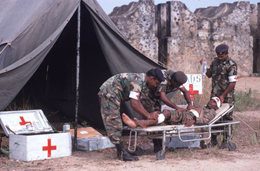Geneva Conventions & Other Treaties and Conventions
4884853452_0dde560837_o-1.aspx?width=260&height=170) The Geneva Conventions
The Geneva Conventions
The Geneva Conventions and their Additional Protocols form the core of international humanitarian law, the body of international law that regulates the conduct of armed conflict and seeks to limit its effects. The Conventions and Protocols specifically protect people who are not taking part in the hostilities, such as civilians, health workers and aid workers, and those who are no longer participating in the hostilities, like wounded, sick and shipwrecked soldiers, and prisoners of war.
- The First Geneva Convention protects wounded and sick soldiers on land during war.
- The Second Geneva Convention protects wounded, sick and shipwrecked military personnel at sea during war.
- The Third Geneva Convention applies to prisoners of war.
- The Fourth Geneva Convention affords protection to civilians, including in occupied territories.
The Red Cross and Red Crescent Movement and the Geneva Conventions
The Red Cross has a unique position under the Geneva Conventions. As a completely neutral and independent organization, the International Committee of the Red Cross (ICRC) can act as an impartial and neutral instrument of humanitarian protection during armed conflicts.
Countries that have signed the Geneva Conventions must allow the ICRC to visit prisoners of war. The ICRC may also exchange family messages and help search for missing persons in countries affected by conflict.
National Red Cross and Red Crescent Societies, such as the Canadian Red Cross, support this work by delivering family messages, and helping to provide medical aid and relief supplies when needed. They also have a special role as voluntary aid societies, auxiliary to the public authorities in the humanitarian field.
Other Treaties and Conventions
In addition to the Geneva Conventions and their Additional Protocols, other agreements prohibit the use of certain weapons and military tactics and protect certain categories of people and goods. These agreements include:
- the 1954 Convention for the Protection of Cultural Property in the Event of Armed Conflict, and its two protocols;
- the 1972 Biological Weapons Convention;
- the 1980 Conventional Weapons Convention, and its four protocols;
- the 1993 Chemical Weapons Convention;
- the 1997 Ottawa Convention on anti-personnel mines;
- the 2000 Optional Protocol to the Convention on the Rights of the Child, on the involvement of children in armed conflict
